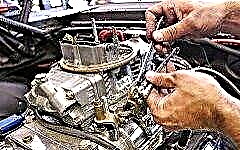
Despite the obsolescence of technology, there are a large number of cars with carburetor engines on the roads. Therefore, the procedure for adjusting this unit is extremely demanded for many car owners. There is also a logical dilemma: try to adjust the carburetor with your own hands, or turn to specialists for help?
The device and principle of operation of the carburetor

Before you start adjusting the unit, you should familiarize yourself with its purpose and internal structure.
Internal combustion engines do not run on pure gasoline, but on an air-fuel mixture. The main function of the carburetor is to mix fuel with air to form this compound. Further, the unit sends the prepared consistency to the power unit, where it burns and acts on the valve blocks.
Primitive carburetor models consist of 2 compartments: mixing and float.
The following actions are carried out in the float chamber:
- gasoline from the tank is directed to the float compartment using a gas pump and passes through a filter;
- the float moves up and is fixed in one position, stopping further fuel flow with the help of a needle valve;
- after consuming a certain amount of fuel, the level in the chamber decreases, the float moves down and opens the valve to supply a new portion of gasoline to the chamber;
- the process is cyclical.
There is a balancing hole in the upper compartment of the chamber, which is responsible for maintaining optimal fuel pressure.
There is a special pipeline between the float chamber and the mixing chamber. The task of the mixing block is to form the working mixture with subsequent transportation to the engine cylinders.
Major carburetor problems

There are several problems with carbureted engines that require immediate system adjustments:
- Fuel leaks. If you find that gasoline is leaking, there may be a defect in the float tank, or a pressure surge. The normal value ranges from 4-7 PSI. If everything is in order with the pressure, the float and the chamber should be checked. This assembly may need to be replaced.
- Dirty spark plugs. During operation, carbon deposits form on the spark plugs with an unpleasant odor, which indicates excessive fuel supply. This is usually due to an incorrect fuel level or a burned-out valve. Also, the problem is provoked by incorrect adjustment of the float, excessive fuel pressure or defects in the float tank. If there are no problems with the fuel level, the condition of the valves should be assessed.
- Unstable operation of the power unit at idle. If, in a normal state, at idle speed, 800 rpm is observed, but soon this figure rises to 1500, you should check the integrity of the wire between the carburetor and the gas pedal. To check the commutation, you need to disconnect the wire and manually press the throttle while the motor is running. If the speed drops to the desired level, then there is a defect in the wire, and it needs to be changed.
DIY customization features

Before starting to adjust the carburetor, warm up the power unit. It is impossible to make adjustments on a cold motor, because it will not bring positive changes. In addition, you will need to remove the gas pedal rod from the throttle valve, turn off the ventilation pipe from the crankcase and make sure there is no vacuum in the advance regulator tube.
After that, you should find the screws that are responsible for adjusting the composition of the mixture (they are also called quality screws) and start tightening them clockwise. Do this until a strange and erratic rumble from the engine appears. When this happens, you need to stop tightening, and unscrew the screw one turn to its previous position. Make sure the unit runs smoothly.
The action is repeated with all screws until the problem is fixed. In addition, it is recommended to clean the carburetor as a preventive measure to prevent future component problems.
Adjusting the carburetor after replacement

Even if you have accurate information about the technical characteristics, make and model of your car, after installing a new, identical to the old carburetor unit, you will have to correctly configure it. This is due to the fact that parameters such as the degree of vacuum at the intake stroke can change during operation.
And if we are talking about installing a third-party carburetor, which is not recommended as a standard unit for your car, then for the correct setting you will not only have to have some theoretical and practical skills, but also prepare the following tools:
- gas analyzers;
- strobe lights;
- measuring devices.
The adjustment process consists of several stages, and the changes made are checked at different loads on the motor. High-quality customization is within the power of a trained expert. But some actions can be performed without the involvement of specialists.
So, if we are talking about adjusting the factory system in order to reduce fuel consumption and increase the power of the car at peak loads, then it is easy to do it yourself.
In addition to changing the quality and volume of fuel in the float tank, you can perform the following actions:
- adjust the air damper drive - when the "suction" lever is recessed, open the damper completely;
- changing the settings of the throttle valve drive is done as follows: you need to depress the accelerator pedal to the stop and open the throttle;
- in order to adjust the carburetor trigger, it is necessary to set the required clearances between the edges of the throttle and choke valves;
- to assess the correctness of the installation of the solenoid valve (EMC), you need to carry out the following test: when dismantling the wires from the EMC, the motor must stall.
Specificity of tuning carburetors of the "Solex" and "Ozone" series

Before the introduction of injection engines on sale, almost all models of the Russian and Soviet automobile industry were supplied with carburetor installations, which were produced at the Dmitrovograd Automobile Unit Plant (DAAZ). The cars of the VAZ concern were equipped with 2-chamber Ozone carburetors until the mid-80s, after which they were replaced by 2-chamber Solex systems.
The listed models differ in the following design characteristics:
- internal structure of the float chamber. Ozone carburetors are mounted on longitudinal engines;
- the Ozone series is distinguished by a lesser whimsy to the quality of fuel, which is due to the characteristic size of the jets. As a result, fuel consumption and acceleration dynamics are much worse than those of Solex;
- in the devices of the Solex line, some improvements were implemented, such as the use of a mechanical throttle valve drive instead of a pneumatic one;
- the Solex design contains a power economizer, which is not available in Ozone.
Two types of carburetors continue to be used in the domestic space to this day. So why regulate them? The fact is that the factory parameters of the Ozone and Solex devices are designed for the characteristic fuel quality and restrained driving style. If the machine is operated in accordance with the manufacturer's recommendations, and the quality of the fuel is satisfactory, then the carburetor can be successfully used for many years without adjustment.
However, it is necessary to periodically check the level of concentration of harmful substances in the exhaust gases, which is done at regular technical inspection. To adjust the carburetor, two screws are used, so such manipulations are easy to do with your own hands.
The algorithm of actions is quite simple: you need to alternately tighten the screws of quantity and quality until a stable and stable operation of the engine at 800-900 rpm is achieved.
An important condition is that the procedure must be carried out on a warm engine.
How to set the ideal parameters with your own hands

For high-quality adjustment of the carburetor, basic devices are needed, which are at the disposal of every car owner. To exclude the flow of an excessive amount of air-fuel mixture, it is worth correctly adjusting the float in the tank. The action is easy to follow with a simple template, but experts do not recommend using this method, since the characteristics of the gaskets in the carburetor assemblies often differ.
Some motorists often use better products instead of standard gaskets. Equipment check is performed as follows:
- tighten the quality screw to the end by hand;
- then it should be unscrewed back 5 turns;
- after starting the engine, you need to remove the suction and bring the speed value up to 750 rpm with the help of the mixture amount screw;
- working with the quality screw, bring the revolutions to the maximum, and then with the quantity screw, reduce them to 800 rpm.
We must not forget that self-adjusting the carburetor not only solves the problem of floating speed, but also has a positive effect on the fuel consumption of the engine at idle speed at stable speeds.
Sometimes beginners have such problems that when the screws of quality and quantity rotate, the power unit does not react to this in any way. This happens if a large jet of fuel moves from the idle hole, and the elements are not able to change it.
The problem appears when the valve is not closed properly or the nozzle is deformed. Sometimes, when replacing the last element, car owners mistakenly choose the inappropriate diameter, or they do not tighten the plug well enough.
It is necessary to carefully inspect all parts of the carburetor to rule out future troubles. When cleaning the jets, do not use formulations with abrasive particles.
If the solenoid valve is damaged, unscrew it and assess for deformation. The seat is also subject to deformation. And if there is a break in the thread, you need to change the carburetor cover. If there is no mechanical damage, it is enough to lubricate the O-ring before unscrewing the jet.
Checking if you need to adjust the carburetor is quite simple. To do this, evaluate the reaction of the engine to pressing the accelerator pedal. The unit, which receives a balanced fuel mixture, responds instantly to pedal action. If the unit is configured correctly, the rpm will be smooth at idle. Any dips and jerks are a sign of any irregularities.
If the unit is running smoothly at idle, but when the speed rises, it shows unstable operation, the quality screw should be tightened and the air-fuel mixture should be enriched.
If the car reacts to pressing the gas pedal with a delay, then there are problems with the accelerating pump - you can change its nose or replace the entire part. If the spout is damaged, the fuel is excessively enriched, but the defect can be eliminated by replacing the spout. If you plan to install a spout of a different diameter, you will need to select a compatible jet.
The quality screw determines the intensity of CO emissions into the environment. If you prefer an aggressive driving style, then the quality screw must be tightened before the scheduled inspection to reduce emissions and get a positive result after the MOT. Then you can return the screw to its previous position.
Conclusion
Adjusting the carburetor is a rather painstaking and complicated process. It may take several weeks to fully resolve powertrain tuning problems. Therefore, you should carefully listen to the operation of the unit and respond in time to any malfunctions in its operation.
During flushing, you should not resort to the use of nameless products from unknown manufacturers. You should also take a responsible approach to the choice of fuel at gas stations, because the uninterrupted and correct operation of all components of the vehicle depends on this.

|| list |
- The device and principle of operation of the carburetor
- Major carburetor problems
- DIY customization features
- Adjusting the carburetor after replacement
- Specificity of tuning carburetors of the "Solex" and "Ozone" series
- How to set the ideal parameters with your own hands
|| rss | Despite the obsolescence of technology, there are a large number of cars with carburetor engines on the roads. There is also a logical dilemma: try to adjust the carburetor with your own hands, or seek help from specialists? __ NEWL ____ NEWL__ Structure and operation of the carburetor__ NEWL ____ NEWL ____ NEWL__Before you start adjusting the unit, you should familiarize yourself with its purpose and internal structure .__ NEWL ____ NEWL__ on the air-fuel mixture. Further, the unit sends the prepared consistency to the power unit, where it burns and acts on the valve blocks .__ NEWL ____ NEWL__ Primitive carburetor models consist of 2 compartments: mixing and float .__ NEWL ____ NEWL__ In the float chamber, the following actions are carried out: __ NEWL ____ NEWL__ gasoline is sent from the gasoline tank through the tank to the float chamber and goes to filter; __ NEWL__ the float moves up and is fixed in one position, stopping further fuel flow with the help of a needle valve; __ NEWL__ after a certain amount of fuel has been consumed, the level in the chamber decreases, the float moves down and opens the valve to supply a new portion of gasoline to the chamber; __ NEWL__ the process is cyclical .__ NEWL__В There is a balancing hole in the upper compartment of the chamber, which is responsible for maintaining optimal fuel pressure .__ NEWL ____ NEWL__ There is a special pipeline between the float chamber and the mixing chamber. The task of the mixing block is to form the working mixture and then transport it to the engine cylinders .__ NEWL ____ NEWL__ Main problems with the carburetor__NEWL ____ NEWL ____ NEWL__ There are several problems that arise with carburetor engines and require immediate adjustment of the system: __ NEWL ____ NEWL__ Fuel leaks. This assembly may need to be replaced .__ NEWL__ Dirty spark plugs. If there are no problems with the fuel level, you need to assess the condition of the valves .__ NEWL__ Unstable operation of the power unit at idle. If the revolutions have dropped to the desired level, then there is a defect in the wire, and it needs to be changed .__ NEWL__ Do-it-yourself tuning features__NEWL ____ NEWL ____ NEWL__ Before you start adjusting the carburetor, you should warm up the power unit. In addition, you will need to remove the gas pedal rod from the throttle valve, turn off the ventilation pipe from the crankcase and make sure that there is no vacuum in the advance regulator tube. twisting clockwise. Make sure the unit runs smoothly .__ NEWL ____ NEWL__ Repeat with all screws until the problem is corrected.In addition, it is recommended to clean the carburetor, which is preventive and aimed at preventing future problems with the unit .__ NEWL ____ NEWL__ Carburetor adjustment after replacement__NEWL ____ NEWL ____ NEWL__Even if you have accurate information about the specifications, make and model of your car, after installing a new, identical old carburetor unit you will have to configure it correctly This is due to the fact that parameters such as the degree of vacuum at the intake stroke can change during operation .__ NEWL ____ NEWL__ And if we are talking about installing a third-party carburetor, which is not recommended as a standard unit for your car, then you will have to do more than just have some theoretical and practical skills, but also prepare the following tools: __ NEWL ____ NEWL__ gas analyzers; __ NEWL__ stroboscopes; __ NEWL__ measuring devices .__ NEWL__ The adjustment process consists of several stages, and the changes made are checked at different loads on the motor. But some actions can be performed without the involvement of specialists .__ NEWL ____ NEWL__So, if we are talking about adjusting the factory system in order to reduce fuel consumption and increase the power of the car at peak loads, then it is easy to do it yourself .__ NEWL ____ NEWL__ In addition to changing the quality and volume of fuel in the float tank, you can also perform the following actions: __ NEWL ____ NEWL__adjust the air damper drive - when the "suction" lever is recessed, the throttle must be fully opened; __ NEWL__the settings for the throttle drive are changed as follows: you need to depress the accelerator pedal all the way and open the throttle; __ NEWL__to adjust the trigger mechanism of the carburetor, you need to set gaps between the edges of the throttle and air valves; __ NEWL__ to assess the correct installation of the solenoid valve (EMC), you need to carry out the following test: when dismantling the wires from the EMC, the motor must stall.











